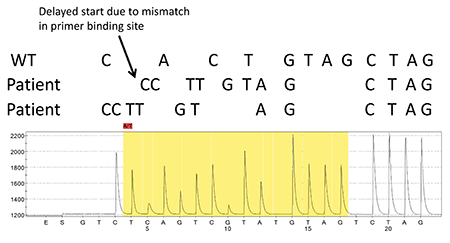
Fig. 6. The S602T alteration was under the pyrosequencing primer sequence. This may have caused the primer to bind inefficiently. A delayed start to elongation may account for the second C peak (position 5 in the strip). Thus, the first C may or may not have been incorporated. If it was not incorporated, then the second C might have been incorporated and this would explain the small second C peak and the G peak in position 7.
To our knowledge, there is only one case in the literature of a patient with V600R and S602T. It occurred in a patient with V600E-negative hairy cell leukemia.5
- Flaherty KT, Puzanov I, Kim KB, et al. Inhibition of mutated, activated BRAF in metastatic melanoma. N Engl J Med. 2010;363(9):809–819.
- Huang PH, Marais R. Cancer: melanoma troops massed. Nature. 2009;459(7245):336–337.
- Capper D, Preusser M, Habel A, et al. Assessment of BRAF V600E mutation status by immunohistochemistry with a mutation-specific monoclonal antibody. Acta Neuropathol. 2011;122(1):11–19.
- Howitt BE, Sholl LM, Dal Cin P, et al. Targeted genomic analysis of Müllerian adenosarcoma. J Pathol. 2015;235(1):37–49.
- Tschernitz S, Flossbach L, Bonengel M, et al. Alternative BRAF mutations in BRAF V600E-negative hairy cell leukaemias. Br J Haematol. 2014;165(4):529–533.
Test yourself
Here are three questions taken from the case report.
Answers are online now at www.amp.org/casereports and will be published next month in CAP TODAY.
1. What percentage of melanoma patients have an activating BRAF mutation?
a) 20–40 percent
b) 40–60 percent
c) 60–80 percent
d) 80–100 percent
2. At present, why isn’t next-generation sequencing the first-line test for BRAF?
a) It has a low sensitivity.
b) It has a low specificity.
c) It has a longer turnaround time compared with other tests.
3. Why is it important to test the BRAF mutational status in melanoma patients?
a) Some BRAF inhibitors are specific to V600E.
b) BRAF mutations can confirm a melanoma diagnosis.
c) It provides useful information about tumor staging.
[hr]Dr. McDonald completed the molecular genetic pathology fellowship at Harvard Medical School. Dr. Kuo is an associate professor of pathology, Brigham and Women’s Hospital, Boston.
 CAP TODAY Pathology/Laboratory Medicine/Laboratory Management
CAP TODAY Pathology/Laboratory Medicine/Laboratory Management
